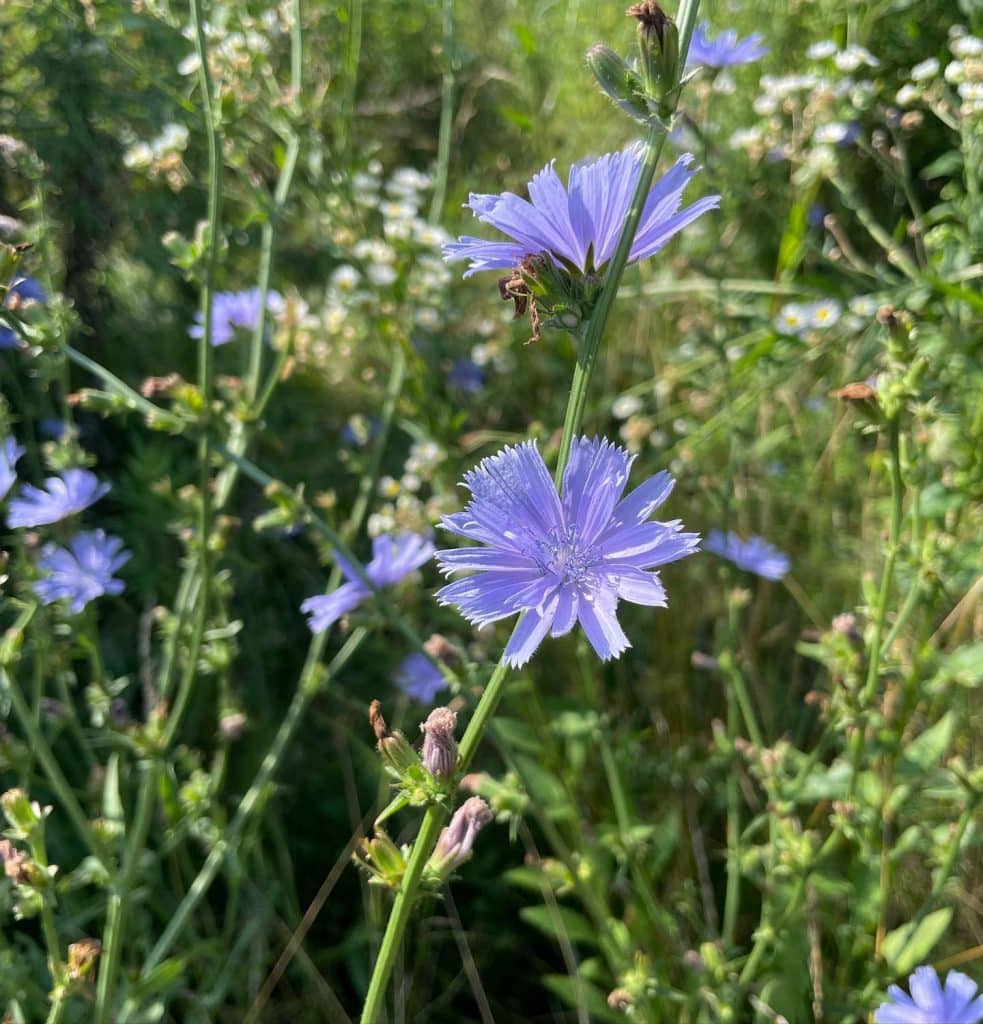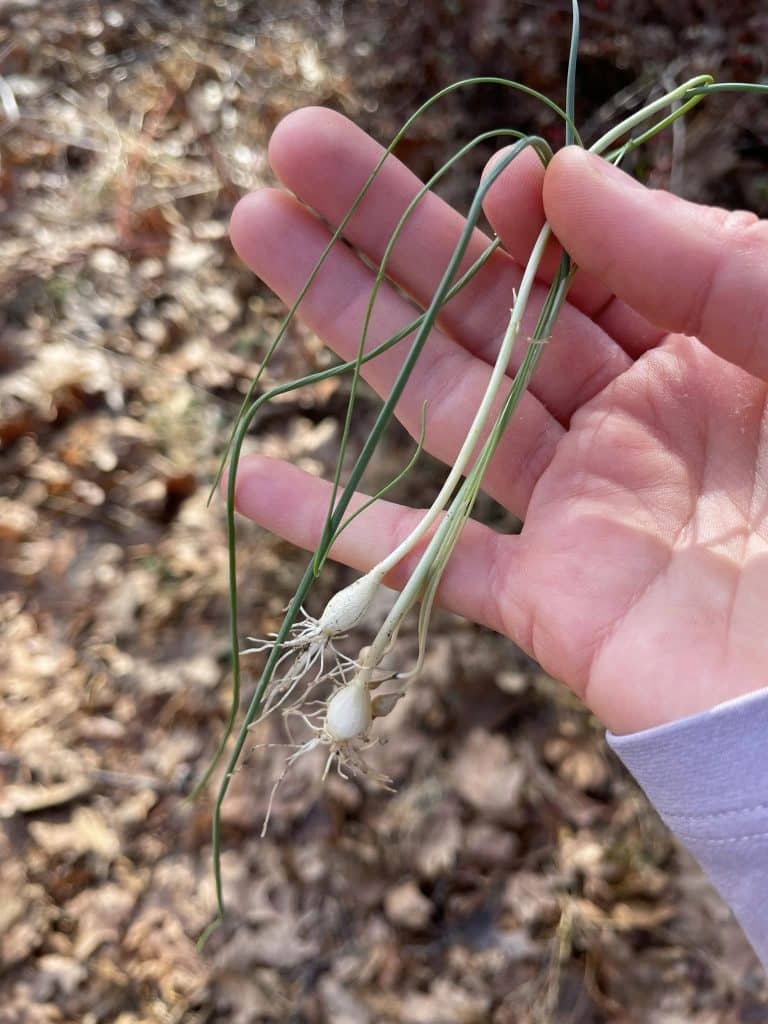Cantharellus minor – Small Chanterelle

The Small chanterelle (Cantharellus minor) is an edible, although unsubstantial mushroom. Small chanterelles are mycorrhizal with hardwood trees. They are often found in moss, under oak trees. Chanterelles can be identified by their decurrent false gills. Small chanterelles look very similar to golden chanterelles but have a slenderer and hollow stem. Although the small chanterelle […]
Cichorium intybus – Common Chicory

Common chicory (Cichorium intybus) is a non-native edible and medicinal plant that can be found in sunny areas. The entire plant is edible, although it can be bitter. It is beneficial to eat bitter herbs, as they assist with digestion, weight management, and blood sugar regulation. Chicory has also been used to boost immunity and […]
Agaricus campestris – Meadow Mushrooms

Meadow mushrooms (Agaricus campestris) are the edible wild cousin of the white button mushroom (Agaricus bisporus). Meadow mushrooms can be identified by their pink gills that turn dark brown with age and their dark brown spore print. The mushroom should not turn yellow when handled and should not be growing from a vulva. Meadow mushrooms […]
Artomyces pyxidatus – Crown-tipped Coral

Crown-tipped coral (Artomyces pyxidatus) is an edible mushroom that can be found from June-September. It fruits on dead or dying wood, which is unique in the coral fungi group. Crown-tipped coral is always a shade of white and has crown-like branch tips. It has a mild peppery flavor and cooks very quickly. It is best […]
Prunella vulgaris – Self-heal

Self-heal/ “Heal-all” (Prunella vulgaris) is a native edible and medicinal plant in the mint family. Self-heal can be identified by its opposite leaves, square stem, and purple flowers that appear mid-late summer. It is found in woodland edges and meadows. All above ground parts can be used as an edible or medicinal. It has a […]
Laetiporus cincinnatus – White-pored Chicken of the Woods

White-pored Chicken of the Woods (Laetiporus cincinnatus) is an edible polypore found growing at the base of oak trees from July-October. There are multiple Laetiporus (Chicken of the Woods) species. The white-pored chicken of the woods is known to be the best tasting species. Laetiporus cincinnatus is lighter colored than other Laetiporus species. It grows […]
Osmorhiza longistylis – Aniseroot

Aniseroot (Osmorhiza longistylis) is an edible plant that tastes and smells like licorice. Aniseroot has a smooth purple stem and small hairs on its leaves. Being in the carrot family, it is imperative to differentiate aniseroot from poison hemlock. Poison hemlock lacks hairs on its leaves, has purple splotches on its stem, and has a […]
Rumex acetosella – Sheep’s Sorrel

Sheep’s sorrel (Rumex acetosella) is an edible, non-native green in the Buckwheat family. Sheep’s sorrel is easily identified by its unique arrow-shaped leaves that grow in a rosette. Sheep’s sorrel is often found near blueberry plants. It prefers sandy soils or grasslands. Sheep’s sorrel has lemony leaves that can be eaten raw or cooked. It’s […]
Rosa palustris – Swamp Rose

The Swamp Rose (Rosa palustris) is a native plant that produces delicious fruits (rose hips) in late fall. All roses have edible leaves, flowers, and hips. Swamp roses have leaves with serrated edges and curved thorns along the stem. They prefer to grow near rivers or marshes. Swamp rose hips have a tangy taste. They […]
Galium aparine – Cleavers

Cleavers (Galium aparine) are a native, edible plant in the coffee family. There are about 20 species in the Galium genus that grow in New England. All Galiums are edible and medicinal. Cleavers are named for their ability to cling to adjacent objects. They have 6-8 leaves per whorl. The plant produces greenish white flowers […]
Betula lenta – Black Birch

Black Birch (Betula lenta) is a native tree with edible sap and cambium (inner bark). Young leaves and trigs can also be eaten or used for flavoring. Black birch has shiny bark with horizontal lenticels (raised pores). Broken twigs have a wintergreen scent from the methyl salicylate in the tree. Twigs can be used […]
Hesperis matronalis – Dames Rocket

Dame’s Rocket (Hesperis matronalis) is an invasive, yet edible plant in the mustard family. In early spring, you can find the basal rosette of Dame’s rocket leaves in disturbed areas. The leaves are covered in small, fuzzy hairs and have irregularly toothed margins. Dame’s rocket leaves taste like peppery arugula. They are best foraged for […]
Cardamine hirsuta – Hairy Bittercress

Hairy bittercress (Cardamine hirsuta) is an edible plant in the mustard family whose leaves can be used as microgreens. Hairy bittercress is named for the tiny hairs that appear on its leaves and stems. It can also be identified by its small white flowers with four petals that are produced in spring. Hairy bittercress thrives […]
Cardamine diphylla – Two-leaved Toothwort

Two-leaved Toothwort (Cardamine diphylla) is a native, edible plant in the brassicaceae (mustard) family. From the root of Two-leaved Toothwort emerges 2 leaves, each with 3 coarsely toothed leaflets. The plant emerges early in spring and blooms from mid-April to mid-May. Two-leaved Toothwort can be found in most of Eastern North America. It often […]
Allium vineale – Field Garlic

Field Garlic (Allium vineale) is a non-native relative of chives that can be foraged in the colder months. Any leaves with a garlicky scent are edible. Field garlic leaves are thin and hollow. All parts of the plant are edible, including the leaves, bulb, and flowers. The bulb can be left in the ground […]
Claytonia virginica – Virginia Spring Beauty

Virginia Spring Beauty (Claytonia virginica) is an edible ephemeral that likes to grow in dappled sunlight. The plant is often found near ramp patches, as both species like to grow in maple-hardwood forests. Virginia Spring Beauty has white to pink flowers with pink stripes. The flowers open when it is warm and sunny. They will […]
Erythronium americanum – Trout Lily

Trout Lily (Erythronium americanum) is a native, edible ephemeral that blooms in April in Connecticut. Trout lily has purple mottled leaves and a flower with 6 petals. The color of the flower varies depending on the species of trout lily. Trout lily leaves and flowers can be added raw to a salad. Only a […]
Thlaspi arvense – Field Pennycress

Field Pennycress (Thlaspi arvense) is a non-native, edible mustard. Field pennycress has alternate, hairless leaves with wavy margins. It produces clusters of white flowers with four petals at the top of the stems. Young leaves can be eaten raw or cooked. After the plant flowers, the leaves will be more bitter. The seeds can be […]
Uvularia sessilifolia – Wild Oats

Wild Oats (Uvularia sessilifolia) is a native woodland plant in the lily family. Wild Oats have alternate leaves that attach directly to the stem. In late April-early May the plant produces a yellow-cream colored flower. Wild Oat shoots can be eaten raw after the leaves are stripped away. Flowers can be added raw to salads. […]
Houstonia caerulea – Quaker Lady Bluet

Quaker Lady Bluets (Houstonia caerulea) are native edible flowers that can be found blooming April-July. Quaker ladies can be distinguished from other bluets by the patch of yellow at their center. Quaker ladies are in the coffee family. They have a taste similar to alfalfa sprouts. An infusion of Quaker lady roots was used by […]
